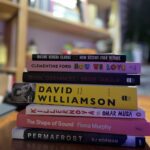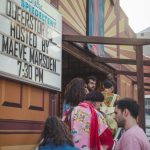I sit and eat my last meal, vegetarian fajitas and a melon smoothie, while the man at the viva mexico table cloth next to mine cheers loudly at the football on the screen. Twenty days and I have barely scratched the surface of this crazy nation.
From Mexico DF, massive, bubbling, teeming, with the grandeur of a mediterranean capital, the feel of Bangkok and Eastern European behemoth apartment blocks, crumbling like their communist counterparts on the other side of the world. Epic murals in the Palacio de las Bellas Artes passionately advocating a nationalistic, anti-capitalist politic, oozing history down colonial hallways, the details explained to me by a funny guide who was well informed about art, but more than a little bit racist. The highlight of the explanation: ‘see there. that is a black man. they are very good at music and sports and the women they think they are good lovers. the white women, they love the black men.’ Totally relevant to the works of Diego Rivera and Rufino Tamayo. The houses of Frida Kahlo, worth the pilgrimmage, but sadly lacking in her work. The casa y estudio, most disappointing with Rivera’s house kept as was and hers turned into a little gallery showing someone else’s work. Damn sexist history.
Arriving amidst Semana Santa, holy week, and experiencing the madness of celebration at the mammoth Basilica de la Guadelupe, where my kind and clever host Beatriz discussed with me the class system of her city and we bought giant cups of cordial and stared at the worshippers as they paraded through the square.
This in contrast with a small church in San Juan Chamula, Chiapas. I stood in that Church for sometime. The marble floor coated with drying pine needles and flowers, small clearings spread by individual worshippers who light the hundreds upon hundreds of small candles that light the space and fill it with a waxy smell that reminds me of my bedroom after I’ve fallen asleep with the candle lit. In various stages of prayer, children clung to to prevent escape, men and women kneeled on the floor, chanted, rocked back and forth, and presented offerings of home made liquor and coca cola.
No priest stood at the front and I was able to walk slowly through and around the people, following the path of the other pale voyeurs, peering into the cabinets lining the walls, at the many manequins dressed regally and labelled saints. Stopped in my tracks, seemingly unashamed of my gawking I stared, transfixed as a woman clutched a chicken by its legs to ensure it did not escape and waved it over her young son’s body. He seemed disinterested in the blessing he received and, like a crying baby at a baptism, he protested by hitting the chicken intermittently. Waving ritual complete, she ay the chicken in her lap and calmly, deliberately, killed it, rubbing the pink and phallic neck firmly with the heel of her hand til it broke, then watching as the head flopped about. Still a little bit alive, she placed it in a plastic bag.
A voyeur. Large and intrusive. I found it hard to develop a solid response to this place. In traditional Christian churches I feel free to judge and criticise religion, but when the religion is unfamiliar, a mingling of ancient Indigenous rituals and introduced Christianity, to criticise can be to colonise, or so it felt. Lengthy debates followed with a German named Bee who I met that day.
In Oaxaca, the beautiful Pueblas Mancomunados, a collective of Zapotec villages who run a successful ecotourism network for intrepid travellers. Hiking their homeland cloud forests, village to village, amazed my body could make it post office-job-limb-crunch and thrilled by soaring horizons, local knowledge of medicinal plants and wildlife so stunning and unique, descending from pine forests, through oak to lush river fringing moss and bromelia. From the home cooked meals of the comedores, making blue tortilla, drinking such fine hot chocolate, to a night of luxury with my fellow hikers – Mexican gastronomical haute cuisine at El Teatro Culinario in Oaxaca City.
The vegetarian organic wonderland of San Cristobal, hippy town in the highlands of Chiapas, ringed by Zapatista communities I knew so little about. The thrill of discovering a small cinema screening a docco on my first night so I could be better informed. And that universal artform of revolutions – the murals – adorning walls of checkpoints when I travelled through the Chiapas countryside. The devastating knowledge that so many of these revolutionaries lost loved ones fighting the government for ridiculous wants like land, health, education and basic human rights.
Palenque. Beautiful ancient Palenque. And Agua Azul, a water wonderland of falls and currents no theme park could build. Pumping my arms against the flow to reach the edge of a waterfall and stand beneath it, my sore muscles pummelled, my bad mood that day erased.
And the tourist hub of Yucatan where I got lost in Walmart for an hour and had a panic attack soon after. People don’t tell you that the biggest danger to peace of mind when travelling can be just that – your mind – struggling daily to make decisions, take in more knowledge than is available to you in a week at home, communicating with new person after new person and questioning all that you have done thus far. If one more fellow tourist says ‘you are only here for __ weeks / days?! But you can’t do ANYTHING in that time,’ I may hit them. Hard.
But Mexico, that country an American official warned me was crazy, soothed my own madness, delivering up charming and talkative hosts, Manolo and Erick, crystalline beaches, private cave pools, ocean paradise and a reprieve from loud mouthed, sun burnt Westerners (including myself). I will come back one day. But for now, I will just feel full. Of fajitas, art, history, natures, people, religion and – of course – cerveza.
















